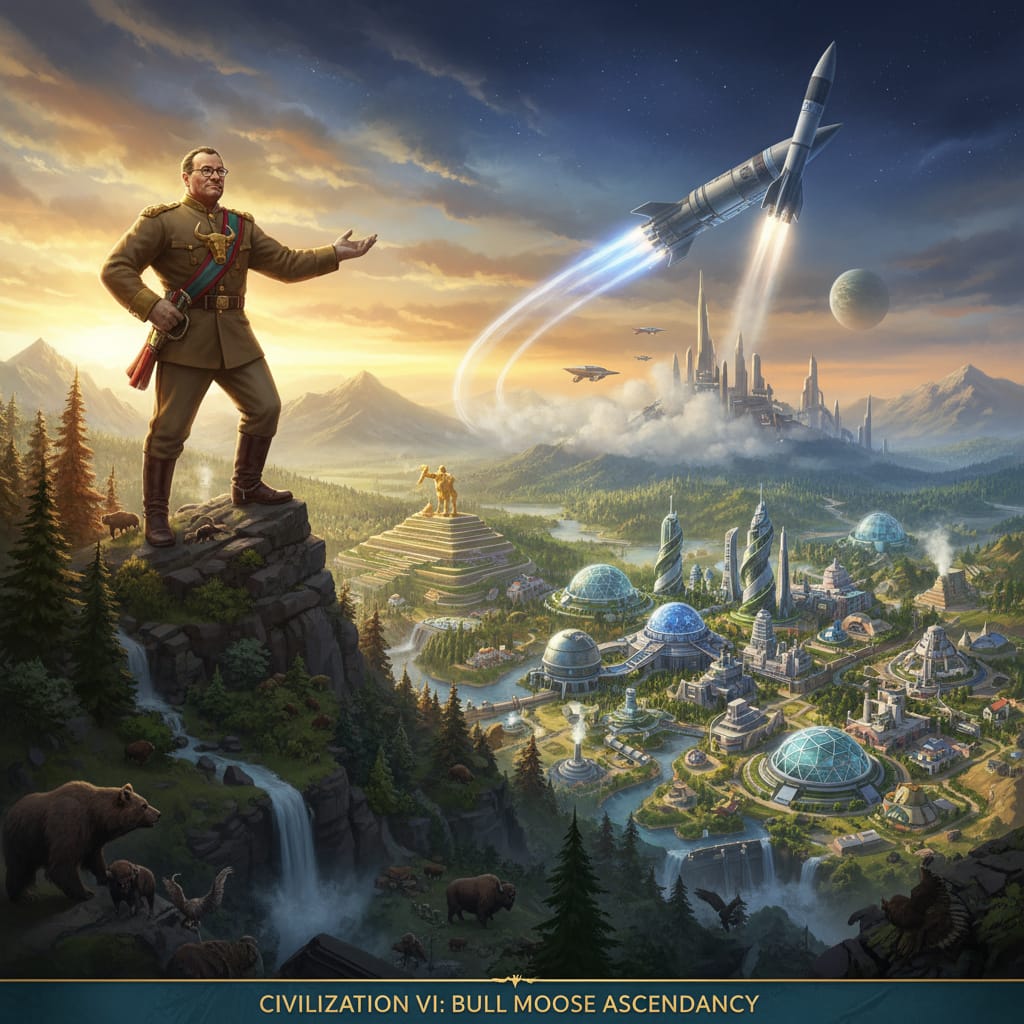In the grand strategy of Civilization 6, achieving a Science Victory is often perceived as a race against time, a relentless pursuit of technology that culminates in the launch of an exoplanet expedition. While many civilizations are well-suited for this path, Teddy Roosevelt, particularly in his “Bull Moose” persona, presents a unique and often underestimated powerhouse for scientific dominance. His abilities, which at first glance appear tailored for a Culture Victory, can be masterfully converted into a potent engine for a late-game science victory. This guide will provide a comprehensive, in-depth analysis of the strategies and tactics required to pivot from a strong foundation into a decisive, science-fueled endgame with Teddy Roosevelt.
The Early and Mid-Game Foundation: Laying the Scientific Groundwork
A successful late-game science victory is not a last-minute endeavor; it is the culmination of strategic decisions made from the very beginning of the game. For Bull Moose Teddy, this means meticulously planning your cities to maximize his unique abilities.
According to the player community, the optimal start for a Teddy Roosevelt science run involves settling near mountains and natural wonders. These geographical features not only provide inherent benefits but also synergize with Teddy’s “Bull Moose” ability, which grants +2 Science to tiles with Breathtaking appeal adjacent to a mountain or natural wonder. This early science boost can be a significant advantage, allowing you to accelerate through the early technology tree and establish a lead over your rivals.
Many professional gamers suggest prioritizing the construction of Preserves in your early cities. The Preserve district, often overlooked in other victory pursuits, is the cornerstone of Teddy’s science strategy. Its buildings, the Grove and the Sanctuary, further enhance the yields of adjacent unimproved tiles. A Sanctuary on a Breathtaking tile adjacent to a mountain, for instance, will yield an impressive +2 Science, +2 Culture, +2 Gold, and +2 Production. This multi-faceted output provides a robust foundation for both scientific advancement and economic stability.
Analysis on forums shows that a common mistake is to neglect appeal. With Bull Moose Teddy, appeal is not just an aesthetic consideration; it is a core mechanic to be manipulated and maximized. Be mindful of the appeal-reducing effects of districts like Industrial Zones and Encampments. Strategic placement is paramount. A popular strategy is to create “super-yield” clusters of tiles by carefully positioning Preserves, wonders, and other appeal-boosting improvements.
The Scientific Powerhouse: Campuses and Great People
While Teddy’s unique abilities provide a significant science income, they are not a substitute for the traditional engines of scientific progress. Campus districts remain the primary source of science generation and should be constructed in every city.
Prioritize the construction of Libraries, Universities, and Research Labs in your Campuses as soon as they become available. The Rationalism policy card, which provides a significant boost to science from Campus buildings, is a must-have in the late game. To maximize its effect, ensure your cities have a high population and that the Campus buildings are fully upgraded.
Great Scientists are the catalysts of a science victory. Their abilities can provide massive boosts to your research, instantly complete technologies, and even contribute to space race projects. Actively pursue Great Scientists by building Campuses, using the “Patronage” policy card, and, if necessary, purchasing them with Gold or Faith. Key Great Scientists to look out for in the late game include Albert Einstein, who provides a significant boost to science per turn, and Carl Sagan, who grants a massive production bonus towards space race projects.
The Production Engine: Fueling the Space Race
The late game of a science victory is a frantic race to complete the space race projects. These projects are incredibly expensive in terms of production, and even the most scientifically advanced civilization will falter without a robust industrial base.
A popular strategy is to designate several cities as “production hubs.” These cities should have a high population, numerous hills for mines, and a well-developed Industrial Zone. The Ruhr Valley wonder, which provides a +20% production bonus in its city, is an invaluable asset for any production hub.
Trade routes are another crucial component of your production engine. In the late game, internal trade routes should be directed to your production hubs to provide them with a steady stream of food and production. Once you unlock the “Globalization” civic, international trade routes become incredibly powerful, providing significant production and gold yields. The Arsenal of Democracy policy card, which grants a bonus to trade routes to your allies, can further amplify this effect.
Many professional gamers suggest a “chop and replant” strategy in the late game. This involves using Builders to chop down forests and rainforests for an immediate production boost. This can be particularly effective for rushing the final stages of a space race project. After chopping, you can use Builders to replant forests, which, when combined with Lumber Mills, will provide a sustainable source of production.
The Space Race: A Step-by-Step Guide
The science victory is achieved by completing a series of five space race projects:
- Launch Earth Satellite: This is the first project and requires the “Rocketry” technology. It provides a significant boost to your science output and reveals the entire map.
- Launch Moon Landing: This project requires the “Satellites” technology and provides a one-time culture bomb, as well as a significant amount of culture.
- Launch Mars Colony: This is the most expensive project and requires the “Nanotechnology” technology. It is the final step before the exoplanet expedition.
- Launch Exoplanet Expedition: This project requires the “Offworld Mission” technology and is the final step to achieving a science victory. The expedition travels at a speed of 1 light-year per turn, and the first civilization to have their expedition travel 50 light-years wins the game.
- Build Terrestrial Laser Stations: To speed up the exoplanet expedition, you can build Terrestrial Laser Stations. Each station increases the expedition’s speed by 1 light-year per turn.
A popular strategy is to have multiple Spaceports in your empire. This allows you to work on multiple space race projects simultaneously, significantly accelerating your path to victory.
The Unseen War: Espionage and Defense
As you approach a science victory, you will become a target for your rivals. They will use spies to sabotage your Spaceports, steal your technologies, and disrupt your production. It is crucial to have a strong defensive spy network to protect your assets.
Place spies in your Spaceport cities with the “Counterspy” mission. This will significantly reduce the chances of successful enemy spy missions. The Intelligence Agency building, which can be constructed in the Government Plaza, provides an additional spy and increases the effectiveness of all your spies.
Offensive spies can be just as valuable as defensive ones. If a rival is close to a science victory, send your spies to their Spaceport cities to disrupt their rocketry. A successful “Disrupt Rocketry” mission can set your rival back several turns, giving you the time you need to secure your own victory.
Teddy’s Unique Advantage: The Bull Moose Strategy in the Late Game
In the final push for a science victory, Teddy Roosevelt’s “Bull Moose” abilities can provide a decisive edge. The synergy between Preserves, National Parks, and the Eiffel Tower can create a cascade of yields that will propel you to victory.
The Eiffel Tower, a late-game wonder, provides +2 appeal to all tiles in your empire. For Bull Moose Teddy, this is a game-changing wonder. It will turn many of your tiles into Breathtaking tiles, which will then benefit from the science and culture bonuses of his “Bull Moose” ability.
National Parks, while primarily a tool for a Culture Victory, can also be a valuable asset for a Teddy Roosevelt science run. They provide a significant boost to the appeal of their city’s tiles, which can further amplify the yields from your Preserves.
Analysis on forums shows that a popular late-game strategy for Bull Moose Teddy is to create “science parks” – clusters of tiles with high appeal, Preserves, and National Parks. These science parks will generate a massive amount of science and culture, allowing you to quickly research the final technologies and civics needed for a science victory.
Conclusion
Converting Teddy Roosevelt’s unique abilities into a science victory is a testament to the strategic depth and flexibility of Civilization 6. It requires a nuanced understanding of the game’s mechanics, meticulous planning, and the ability to adapt to changing circumstances. By leveraging the power of appeal, Preserves, and a robust industrial base, you can transform the “Bull Moose” into a scientific titan, leaving your rivals in the dust as you launch your exoplanet expedition and secure your place in the stars. This path to victory is not just about accumulating science; it is about creating a harmonious and productive civilization, a true testament to the enduring legacy of Teddy Roosevelt.


